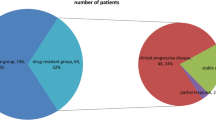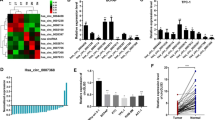Abstract
MicroRNAs (miRNAs) are small non-coding RNAs that post-transcriptionally regulate gene expression. The aberrant expression of miRNA has become a major focus in cancer research. This study aimed to investigate the importance of miR-410 in the diagnosis and therapy of osteosarcoma (OS). Western blot analysis showed that the expression of VEGF was higher in Saos-2 and MG-63 cells than that in three other OS cell lines. We also found that miR-410 was lowly expressed and inversely correlated with VEGF expression in OS specimens. Over-expression of miR-410 had a greater repression on VEGF expression than other candidate VEGF-targeting miRNAs. Luciferase reporter assay demonstrated that miR-410 directly decreased VEGF expression by targeting its 3′-untranslated region. Further investigation demonstrated the regulation of miR-410 in OS cells via VEGF. In vitro MTT assay, Transwell, and flow cytometry showed that transfection of the miR-410 expression plasmid inhibited cell proliferation and contributed to apoptosis in OS cells. Moreover, restoration of VEGF reversed the effect of miR-410 on OS cells, and upregulated the expression of phosphorylated AKT. Finally, overexpression of miR-410 also showed a negative effect on tumor growth in vivo. Our findings suggest a cooperative relationship between miR-410 and VEGF in OS cell regulation. This information may help researchers to better understand miRNA regulation in cancer and provide a rationale for developing miRNA-based strategies for OS treatment.




Similar content being viewed by others
References
Tan JZ, Schlicht SM, Powell GJ, Thomas D, Slavin JL, Smith PJ, Choong PF (2006) Multidisciplinary approach to diagnosis and management of osteosarcoma—a review of the St Vincent’s Hospital experience. Int semin surg oncol 3:38. doi:10.1186/1477-7800-3-38
Akiyama T, Dass CR, Choong PF (2008) Novel therapeutic strategy for osteosarcoma targeting osteoclast differentiation, bone-resorbing activity, and apoptosis pathway. Mol Cancer Ther 7(11):3461–3469. doi:10.1158/1535-7163.MCT-08-0530
Ferrari S, Palmerini E (2007) Adjuvant and neoadjuvant combination chemotherapy for osteogenic sarcoma. Curr Opin Oncol 19(4):341–346. doi:10.1097/CCO.0b013e328122d73f
van Rooij E (2011) The art of microRNA research. Circ Res 108(2):219–234. doi:10.1161/CIRCRESAHA.110.227496
Slezak-Prochazka I, Durmus S, Kroesen BJ, van den Berg A (2010) MicroRNAs, macrocontrol: regulation of miRNA processing. RNA 16(6):1087–1095. doi:10.1261/rna.1804410
Terentyev D, Belevych AE, Terentyeva R, Martin MM, Malana GE, Kuhn DE, Abdellatif M, Feldman DS, Elton TS, Gyorke S (2009) miR-1 overexpression enhances Ca(2+) release and promotes cardiac arrhythmogenesis by targeting PP2A regulatory subunit B56alpha and causing CaMKII-dependent hyperphosphorylation of RyR2. Circ Res 104(4):514–521. doi:10.1161/CIRCRESAHA.108.181651
Maraghechi P, Hiripi L, Toth G, Bontovics B, Bosze Z, Gocza E (2013) Discovery of pluripotency-associated microRNAs in rabbit preimplantation embryos and embryonic stem-like cells. Reproduction 145(4):421–437. doi:10.1530/REP-12-0259
Yang H, Kong W, He L, Zhao JJ, O’Donnell JD, Wang J, Wenham RM, Coppola D, Kruk PA, Nicosia SV, Cheng JQ (2008) MicroRNA expression profiling in human ovarian cancer: miR-214 induces cell survival and cisplatin resistance by targeting PTEN. Cancer Res 68(2):425–433. doi:10.1158/0008-5472.CAN-07-2488
Hayashita Y, Osada H, Tatematsu Y, Yamada H, Yanagisawa K, Tomida S, Yatabe Y, Kawahara K, Sekido Y, Takahashi T (2005) A polycistronic microRNA cluster, miR-17-92, is overexpressed in human lung cancers and enhances cell proliferation. Cancer Res 65(21):9628–9632. doi:10.1158/0008-5472.CAN-05-2352
Frankel LB, Christoffersen NR, Jacobsen A, Lindow M, Krogh A, Lund AH (2008) Programmed cell death 4 (PDCD4) is an important functional target of the microRNA miR-21 in breast cancer cells. J Biol Chem 283(2):1026–1033. doi:10.1074/jbc.M707224200
Weiss FU, Marques IJ, Woltering JM, Vlecken DH, Aghdassi A, Partecke LI, Heidecke CD, Lerch MM, Bagowski CP (2009) Retinoic acid receptor antagonists inhibit miR-10a expression and block metastatic behavior of pancreatic cancer. Gastroenterology 137(6):2136–2145. doi:10.1053/j.gastro.2009.08.065 e2131–2137
Migliore C, Martin V, Leoni VP, Restivo A, Atzori L, Petrelli A, Isella C, Zorcolo L, Sarotto I, Casula G, Comoglio PM, Columbano A, Giordano S (2012) MiR-1 downregulation cooperates with MACC1 in promoting MET overexpression in human colon cancer. Clin cancer res 18(3):737–747. doi:10.1158/1078-0432.CCR-11-1699
Xu Q, Liu LZ, Qian X, Chen Q, Jiang Y, Li D, Lai L, Jiang BH (2012) MiR-145 directly targets p70S6K1 in cancer cells to inhibit tumor growth and angiogenesis. Nucleic Acids Res 40(2):761–774. doi:10.1093/nar/gkr730
Liu C, Kelnar K, Liu B, Chen X, Calhoun-Davis T, Li H, Patrawala L, Yan H, Jeter C, Honorio S, Wiggins JF, Bader AG, Fagin R, Brown D, Tang DG (2011) The microRNA miR-34a inhibits prostate cancer stem cells and metastasis by directly repressing CD44. Nat Med 17(2):211–215. doi:10.1038/nm.2284
Huang G, Nishimoto K, Zhou Z, Hughes D, Kleinerman ES (2012) miR-20a encoded by the miR-17-92 cluster increases the metastatic potential of osteosarcoma cells by regulating Fas expression. Cancer Res 72(4):908–916. doi:10.1158/0008-5472.CAN-11-1460
Zhao H, Ma B, Wang Y, Han T, Zheng L, Sun C, Liu T, Zhang Y, Qiu X, Fan Q (2013) miR-34a inhibits the metastasis of osteosarcoma cells by repressing the expression of CD44. Oncol Rep 29(3):1027–1036. doi:10.3892/or.2013.2234
Cai CK, Zhao GY, Tian LY, Liu L, Yan K, Ma YL, Ji ZW, Li XX, Han K, Gao J, Qiu XC, Fan QY, Yang TT, Ma BA (2012) miR-15a and miR-16-1 downregulate CCND1 and induce apoptosis and cell cycle arrest in osteosarcoma. Oncol Rep 28(5):1764–1770. doi:10.3892/or.2012.1995
He C, Xiong J, Xu X, Lu W, Liu L, Xiao D, Wang D (2009) Functional elucidation of MiR-34 in osteosarcoma cells and primary tumor samples. Biochem Biophys Res Commun 388(1):35–40. doi:10.1016/j.bbrc.2009.07.101
Chen L, Zhang J, Feng Y, Li R, Sun X, Du W, Piao X, Wang H, Yang D, Sun Y, Li X, Jiang T, Kang C, Li Y, Jiang C (2012) MiR-410 regulates MET to influence the proliferation and invasion of glioma. Int J Biochem Cell Biol 44(11):1711–1717. doi:10.1016/j.biocel.2012.06.027
Gattolliat CH, Thomas L, Ciafre SA, Meurice G, Le Teuff G, Job B, Richon C, Combaret V, Dessen P, Valteau-Couanet D, May E, Busson P, Douc-Rasy S, Benard J (2011) Expression of miR-487b and miR-410 encoded by 14q32.31 locus is a prognostic marker in neuroblastoma. Br J Cancer 105(9):1352–1361. doi:10.1038/bjc.2011.388
Carbajo-Pescador S, Ordonez R, Benet M, Jover R, Garcia-Palomo A, Mauriz JL, Gonzalez-Gallego J (2013) Inhibition of VEGF expression through blockade of Hif1alpha and STAT3 signalling mediates the anti-angiogenic effect of melatonin in HepG2 liver cancer cells. Br J Cancer 109(1):83–91. doi:10.1038/bjc.2013.285
Ugarte-Berzal E, Redondo-Munoz J, Eroles P, Del Cerro MH, Garcia-Marco JA, Terol MJ, Garcia-Pardo A (2010) VEGF/VEGFR2 interaction down-regulates matrix metalloproteinase-9 via STAT1 activation and inhibits B chronic lymphocytic leukemia cell migration. Blood 115(4):846–849. doi:10.1182/blood-2009-08-239426
Findley CM, Cudmore MJ, Ahmed A, Kontos CD (2007) VEGF induces Tie2 shedding via a phosphoinositide 3-kinase/Akt dependent pathway to modulate Tie2 signaling. Arterioscler Thromb Vasc Biol 27(12):2619–2626. doi:10.1161/ATVBAHA.107.150482
Lee KS, Park SJ, Kim SR, Min KH, Lee KY, Choe YH, Hong SH, Lee YR, Kim JS, Hong SJ, Lee YC (2008) Inhibition of VEGF blocks TGF-beta1 production through a PI3K/Akt signalling pathway. Eur Respir J 31(3):523–531. doi:10.1183/09031936.00125007
Acknowledgments
This project was supported by National Natural Science Foundation of China (81201281), Natural Science Foundation of Hebei Province of China (C2012401037, H2013209180), and the project of Science and Technology from Government of Tangshan City of Hebei Province (12140209A-4).
Conflict of interest
The authors have no conflict of interest.
Author information
Authors and Affiliations
Corresponding authors
Rights and permissions
About this article
Cite this article
Zhao, D., Jia, P., Wang, W. et al. VEGF-mediated suppression of cell proliferation and invasion by miR-410 in osteosarcoma. Mol Cell Biochem 400, 87–95 (2015). https://doi.org/10.1007/s11010-014-2265-2
Received:
Accepted:
Published:
Issue Date:
DOI: https://doi.org/10.1007/s11010-014-2265-2




